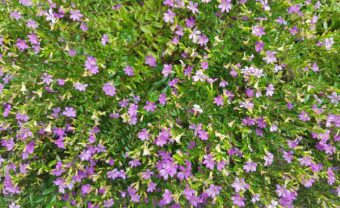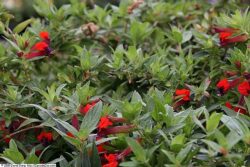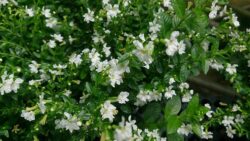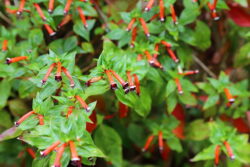In this article, we will discover how to grow the wonderful colourful plant of Cuphea in containers. The plant has many common names depending on what variety and species are grown. You may find them sold as firecracker plants, cigar flower, Mexican cigar plant, Bat Ear flower, Bunny Ears or False heather. It is a tender perennial/sub-shrub that is often grown as an annual in the UK.

The leaves are glossy, oblong and come in shades from bright green to bluish-green, but they are nothing compared to the flowers that are produced. The flowers are typically long and tubular in nature but some cultivars have ear-shaped petals that look like mice or bat ears. The flowers tend to be warm, vibrant red and orange, whilst some cultivars are pink, lavender or purple in colour. Whites are also possible so you do have a choice. The flowers may be small but they make up by producing them in large qualities.
These 60cm tall plants look stunning as specimen plants in containers, where the vibrant colours can be enjoyed.
The flowers are very attractive to pollinators and therefore recommend for those who wish to attract wildlife. The flowers appear for a long time from summer to the first frosts.
One species that is hardy to -5 degrees Celsius is Cuphea hyssopifolia, but to guarantee plant survival you will need to bring the plants indoors or cover them with thick, horticultural fleece. The other species are less hardy, especially Cuphea ignea that needs to be brought under the protection of a greenhouse, conservatory or home to survive.
Cuphea itself is a fairly large genus with over 260 species all originating from Central and South America. Most are not cultivated for the home garden and so you will only find a few species sold online or in garden centres. You will either find them sold as seeds or as garden-ready plants.
HOW TO GROW CUPHEA IN CONTAINERS
As said earlier it can be grown from seed or garden-ready plants. If you are growing from seed, you will need to start indoors from 10 to 12 weeks before the last frost date, sometime in February or March.

To do this, fill a seed tray with seed sowing compost and water it well, allowing the excess water to drain away. On top of the compost, sprinkle the seeds lightly and press them into the surface. Do it gently so that you do not damage the seeds. Do not cover with more compost as they need light to germinate. Place it in a warm, sunny windowsill and cover the seed tray with a propagator lid.
After 8 to 10 days the seeds will germinate and once two true leaves have formed, you can prick them out and transplant them into 7.5cm pots full of multipurpose compost. Do not start seeds directly outdoors as in the UK it can be hit and miss.
Once the plants have established and frosts are on the way out, you can harden them off, ready to be planted outside.
TREAT HOME-REARED SEEDS AND GARDEN READY PLANTS THE SAME
At this stage home-reared plants and shop-bought, garden-ready plants can be treated in the same way.
First, choose a 30cm diameter container that has plenty of drainage holes. On top of the bottom of the container, place a 1cm layer of gravel to aid drainage and on top of this add enriched, multipurpose compost. Dig a hole in the compost that is slightly bigger than the root ball it came in the original container. Place the plant in the hole so that the top of the root ball is at the same level as the top surface of the compost. Backfill with the growing media, ensuring that any gap that remains is filled with more compost if necessary.
Firm the plant in and water well.

Place the container so that it can get the most sunlight but in hot summers it will appreciate being in a bit of shade. Water regularly until the plant is established but never overwater. Water when 5cm below the top surface of the compost feels dry to the touch. Only water until it appears at the drainage holes.
Fertilize your plants with a high potash liquid fertilizer every month during the growing season. One advantage is that the plant will not need to be deadheaded, as dead flowers will drop off naturally and the plant will continuously produce. You can prune in late spring, early summer to produce a more compact, bushier, plant, encouraging more flowers to be produced.
PESTS AND DISEASES
The good news is that these plants tend to not suffer from many pests and diseases. Diseases are rare but they can suffer from whiteflies and aphids. Spray with jets of water to dislodge them or if it is suffering from large infestations, then you can spray with a suitable systemic insecticide.
VARIETIES TO GROW
The following are varieties recommended to be grown in containers:

Cuphea ignea (Mexican Cigar Plant) is a shrubby perennial with little red tubular flowers tipped black and white.
Cuphea hyssopifolia (False Heather) is a borderline, hardy, evergreen shrub that has dark green leaves that has purple, pink, or white flowers.
Cuphea ‘Funny Face’ is an annual with bright, burgundy flowers with yellow tips, white stamens that stick out like a tongue. A heat-tolerant plant.
CONCLUSIONS
In this article, we have discussed how to grow Cuphea in containers. They are normally tender perennials treated as annuals or some species like Cuphea hyssopifolia are borderline hardy if you are prepared to bring it indoors or in a greenhouse over winter. They are such colourful plants with long often tubular flowers that set off the green leaves.
If you want an annual that should be grown in container garden displays, then this is the plant for you.
If you have any questions or comments that you wish to make on growing Cuphea in containers, please do so in the comment box below.
Happy Cuphea growing.
